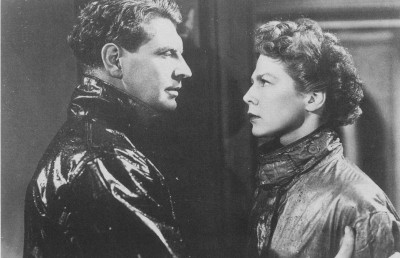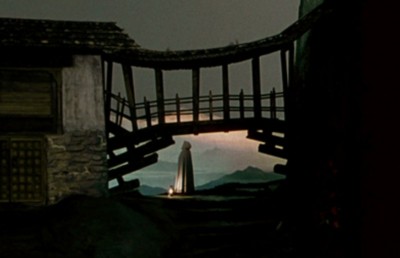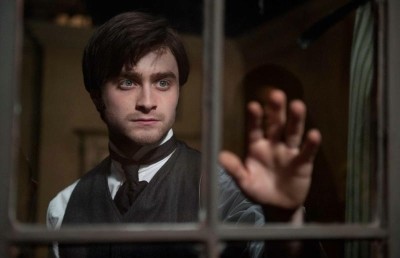A Tale for Our Times: The Criterion 2-disc edition of Powell and Pressburger’s A Canterbury Tale
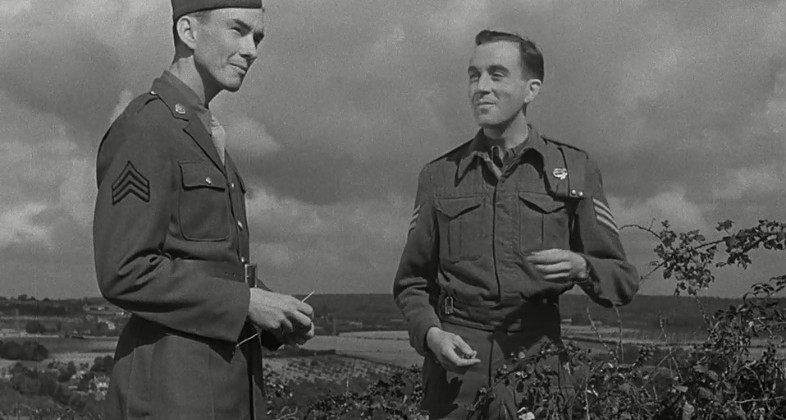
With the 2-disc edition of Michael Powell and Emeric Pressburger’s A Canterbury Tale (1944) Criterion continues its meticulous dedication to two of Britain’s greatest film artists. With regard to their work as a team, Criterion has previously reissued The Thief of Bagdad (1940), The Life and Death of Colonel Blimp (1943), I Know Where I’m Going! (1945), Black Narcissus (1947), The Red Shoes (1948), The Small Back Room (1949) and Tales of Hoffman (1951). The arrival of the Criterion edition of A Canterbury Tale (1944) provides students of film an opportunity to delve even more deeply into what many critics regard as the Archers’ most productive decade and arguably one of the richest periods in British film history. As someone who has been following with great relish the Criterion excavation of the Archer’s work I can certainly attest to the validity of Lindsay Anderson’s observation, in his review of Powell’s Million Dollar Movie: A Life in Movies, that “Powell and Pressburger were surely the most extraordinary partnership ever to come out of British cinema.”
With A Canterbury Tale Criterion continues its tradition of providing DVD (and, increasingly, Blu-Ray) packages which combine pristine transfers of primary texts with well chosen supplementary materials that enrich our understanding of the film and also often possess intrinsic interest. Indeed, it is no exaggeration to say that, as with so many other Criterion reissues, the relationship between primary and secondary texts for the Criterion A Canterbury Tale is richly intertextual, with the primary text, the film itself, as the centerpiece of a richly woven mosaic.
Another Criterion trademark, the pristine quality of the transfer, allows for renewed appreciation of the film’s visual style. While critical raves have been particularly plentiful for the opulent use of color in such films as The Red Shoes and Tales of Hoffman, this film reminds us that the Archers’ use of black and white cinematography was equally brilliant. Although cinematography Erwin Hillier became known as a specialist in the kind of chiaroscuro lighting associated with film noir, in A Canterbury Tale he exhibits a deft capacity for lighting which combines scenes with highly expressionistic lighting, and scenes of evenly lit documentary realism. As well, it is virtually impossible for even the most perceptive viewer to distinguish between what has been filmed in the studio and what has been shot on location. The combination of Hillier’s cinematography and Michael Powell’s attention to detail makes for scenes in which the mise-en-scene is astonishingly complex but somehow never self-conscious.
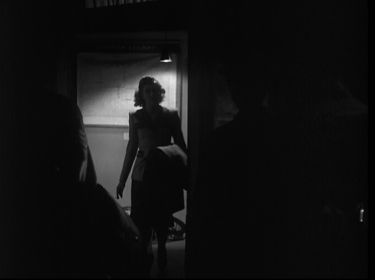
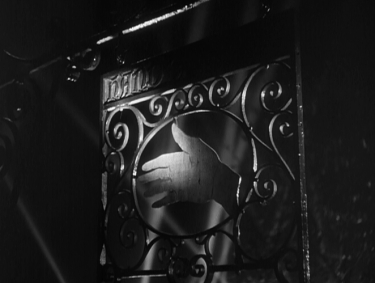
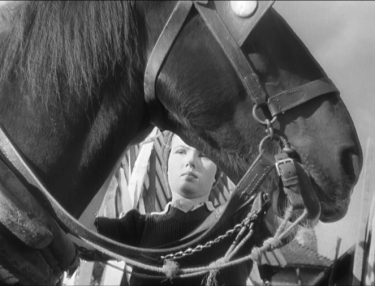
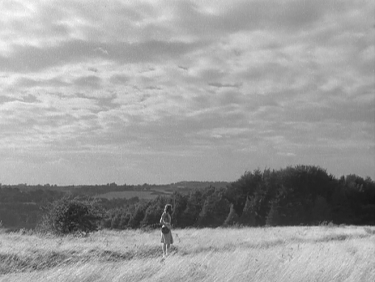
Chiaroscuro vs. Realism
While ‘poetic realism’ is particularly associated with French films of the 1930s, and is admittedly open to shadings of definition, it seems to me a perfectly apt term to apply to A Canterbury Tale. The film vividly delineates a specific place and time, and is remarkably sophisticated in its exploration of the nuances of human interaction. But emerging seamlessly from this realistic framework is a complex pattern of themes and motifs that somehow invest the film with luminous transcendence and thereby suggest that the spiritual is not opposite from but inextricably bound up with, the quotidian.
The commentary track for the film is provided by film historian Ian Christie. Though the choice of Christie is an obvious one, it is none the less judicious. Here is someone who has been a student of the Archers’ work for decades and has published extensively on them. He is author of the BFI Film Classics monograph on A Matter of Life and Death and co- editor (with Andrew Moor) of Michael Powell: International Perspectives on an English Filmmaker. He also has an established association with Criterion, having provided an audio essay for I Know Where I’m Going!, an audio commentary for The Red Shoes and an essay for the Criterion Tales of Hoffmann. And I am sure that I am not alone in having found his Arrows of Desire ( 1985) a highly useful guide to my first forays into a serious consideration of the Archers’ work. The high calibre of the commentary does place some demands on the viewer. Often with DVD commentary tracks, the commentary itself is timed for lulls in the dialogue, or the audio track of the film proper is muted when a commentator wants to be heard. The commentary here virtually reverses this trend. Christie talks throughout the whole film, and the audio track of the film proper is usually muted and only occasionally brought to the fore.
In the wrong hands, such a tactic could have been disastrous. But Christie is, frankly, so insightful that the experience is rather like a two-hour guided tour through the world of the film, with the film playing in virtual silence, as a kind of sustained backdrop illustration. Rather more successfully than Colpepper’s magic lantern show in the film itself, Christie offers an analysis of the film that is particularly astute with respect to several pertinent historical contexts including: the literary and cultural history of Kent and of Canterbury in particular; the film’s intricate production history; the situation of the film within the Archers’ oeuvre and the place of the film within British cinema as a whole. Although the commentary is best appreciated after one has watched the film, it should not be missed.
In addition to the film itself and Ian Christies’s commentary, disc one of the Criterion A Canterbury Tale includes an additional treat. As impossible as it is to imagine now, A Canterbury Tale was not deemed a success on its initial release. For American distribution, Powell cut 20 minutes from the film and even added a new character, John’s wife (played by Kim Hunter). In the American version, the narrative is reshuffled so that the unfolding action now becomes a flashback, with John telling his new bride of his war time Canterbury adventures. Included from the American version are a prologue (setting up the flashback structure) and an epilogue that brings us back to John and his wife, who he has persuaded to travel to Canterbury so that he can share with her what he had experienced during the war. Frankly, both the prologue and the epilogue are cringe-inducing, but they inadvertently function as poignant reminders of how crass marketing imperatives can lead to the mutilation of a film, a work in this case that was profoundly underappreciated at the time of its release.
As mentioned, the supplementary materials on disc two are excellent, and worthy of brief overview. First up is a video interview with Sheila Simm, filmed in February 2006 exclusively for the Criterion Collection edition of A Canterbury Tale. Despite its brevity, the interview is insightful and even moving. Simm (Lady Attenborough) begins by acknowledging the challenges of recalling events from 60 years ago, but her memory is actually razor sharp. She talks about the past and through judicious use of illustrations from A Canterbury Tale we are given a powerful sense of the impact on her of the experience of being involved in the project. Simm has obviously thought deeply about her craft and has several insights to offer on the film’s performances. She lauds the understatement of John Sweet’s performance, and makes a subtle distinction between Eric Portman’s more method-like embodiment of his character, versus the tendency of Dennis Prise to be more of a personality actor. Of her famous scene with Eric Portman on the hill, she confides that it was actually one of her less challenging scenes, since the long take shooting enabled her to approach it in a way more reminiscent of her RADA training. She also echoes a point about Michael Powell that other actors have certainly expressed: “Michael could be very tough on actors…I think he was a little nervous of them.” One of her final observations in the documentary about her reminds us that growing old does not necessarily have to involve becoming close-minded: “What I do find rather difficult [in the film] is the village idiot.” Simm, rightly, finds the comic characterization of that figure distasteful, a rare blemish on an otherwise brilliant film.
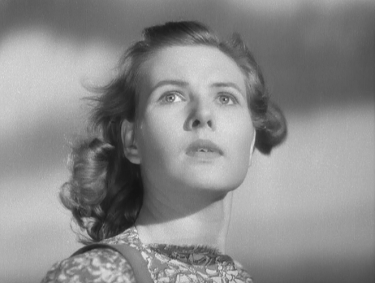
Sheila Simm
Simm is also honest enough to hint at a larger problem with regard to A Canterbury Tale. The film certainly addresses issues of class and the entry of the John Sweet character into the mix certainly enables the film to explore the relationship between British and American cultural identities. But the film’s vision of England and Englishness is exclusively white and predominantly Anglophone. As Simm points out, “Now there is great discussion about Englishness and Britishness…Maybe we feel, rightly or wrongly, that we are losing something that we had back then.” Is A Canterbury Tale at risk of seeming like a museum piece, an artifact that captures England in a frozen moment of its colonialist past? If we are inclined to deride the film’s cultural homogeneity, it certainly can be said in its possible defense that, at least in that regard, it is no different than virtually every other film of its time. Not until the late 50s and early 60s, in films like Sapphire (1959) and A Taste of Honey (1961) would British cinema take tentative steps toward the exploration of race and racial prejudice. But, the film is, I think, also defensible on the grounds that it grapples quite directly with the very problem of what changes in a nation over time and what remains or ideally should remain. The “pilgrims” in the film’s World War II time frame face different challenges and have different priorities than Chaucer’s pilgrims. Yet, all are shown to be searching for human connection, for an understanding of their place in the larger cosmos, with love and art and nature all figuring large in that very human quest.
One day every summer in Kent, local historian Paul Tritton and Powell and Pressburger enthusiast Steve Crook lead a walking tour of the film locations for A Canterbury Tale. In 2005, the centennial of Michael Powell’s birth, documentary filmmaker David Thompson shot footage of the tour and other location sites. While the premise of this short documentary may sound mundane, the results are anything but. The documentary opens with and frequently returns to shots from A Canterbury Tale, thereby weaving together past and present in a way reminiscent of A Canterbury Tale itself. The people who take the walking tour are shown to be “pilgrims” in the tradition of Powell and Pressburger’s and of Chaucer’s own. The film includes remarkable photos of Powell as a child and makes a very persuasive case for just how autobiographical for Powell A Canterbury Tale really is.
A Canterbury Trail was made by David Thompson, one of Britain’s foremost creators of documentaries about film culture. His work includes films on Vittorio Storaro, Jean Renoir, Josef von Sternberg, Ennio Morricone, Busby Berkeley, Paul Scofield, Alec Guinness and others. His film on Paul Scofield, for example, is a nuanced and moving portrait of the actor, no small accomplishment given Scofield’s penchant for privacy in his personal life. One of the paradoxes of documentary filmmaking of the kind that Thompson excels at is that when the filmmaker is doing his or her job well, the viewer is focused squarely on the subject, not on the filmmaker’s craft. But Thompson’s work is definitely worth looking out for. As of this writing, his excellent documentaries on Paul Scofield and Ingmar Bergman for the BBC’s Arena series are available (hopefully by permission) on Youtube and are highly recommended. His film on the Arthur Freed Unit at MGM is available on the Warners 2-disc special edition of Singin’ In The Rain. The first part of his major, two-part documentary on Jean Renoir is on the Criterion disc of Rules of the Game, and part two can be found on the Criterion Jean Renoir: Stage and Spectacle collection.
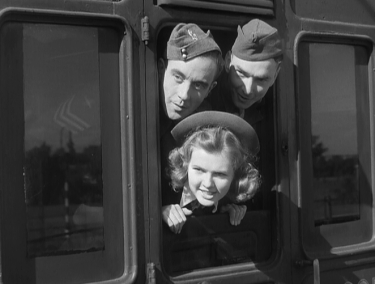
Although intriguing, the inclusion as one of the supplements to A Canterbury Tale of Victor Burgin’s video installation, Listen to Britain, is not entirely successful. The seven minute work, meant to run as a loop with no definable beginning, middle and end, mixes various elements, including contemporary landscape footage of locations from A Canterbury Tale, the famous shot (absent the sound) of Allision “hearing” sounds from Canterbury’s past, a brief extract of her equally famous dialogue with Colpepper on the hill used as voice-over to additional contemporary footage. As Burgin himself makes clear in his written introduction, the intended art gallery context for the installation is totally different from that of the cinema, and there is no doubt that something is lost in the experience of such a work outside of its intended context. But one of Burgin’s remarks in his written introduction ends up arguably carrying more weight than the installation (at least in this setting) itself. The artist points out that the piece originated in 2001, after his return to England after living many years abroad. He was struck on his return with the enduring beauty of the landscape, but he also notes that England, post 9/11, felt under siege for the first time since the second world war. I think Burgin’s remarks provide a clue to one of the reasons why A Canterbury Tale has had such a powerful hold on successive generations of viewers. On its original release, though not fully appreciated, the film presented a vision of the fragility of human values and of nature during a time of war. In current times, and particularly since 9/11, that sense of fragility is renewed and we are reminded that “progress” in terms of materialism and technology does not necessarily equate with global enlightenment. In this context, the figure of the Glue Man becomes at once more timely and ambiguous. On one level, he can be read as a zealot whose deep commitment to nature and traditional values leads him to petty acts of defiance against complacency. Is he best read as a kind of small scale eco-terrorist whose desperation has a sympathetic side and serves as a reminder of just how prone we are to squander our natural resources? Or, is he a figure that reminds us that deep conviction can evolve into fanaticism of a kind that could lead to far worse than a bit of glue in one’s hair?
The documentary on John Sweet is, for me, the highlight of the extras. In 2001 Nick Burton and Eddie McMillan produced John Sweet: A Pilgrim’s Return on the occasion of John Sweet’s first visit back to Canterbury since the making of the film. Sweet and his co-star, Sheila Simm were attending the Kent International Film Festival and its annual Michael Powell celebrations. The interview with Sweet is held in a café which was the model for the studio-created café scene. Sweet marvels at the changes to Canterbury, including the ubiquitous signs of tourism. He quotes Henry James: “What you see is what you bring”. What Sweet brings is a real insight into the film. The documentary interweaves interview scenes with shots from the film (with Sweet’s observations continuing) so that the little film doubles as a doc on Sweet and a kind of commentary track by Sweet on a few key scenes. He seems to feel a gratitude for his involvement in such a masterwork, but he is also refreshingly wary of his own celebrity. The documentary on him actually exemplifies this very dilemma: he is the subject of the documentary because of his association with the film, but clearly he is a subject of considerable intrinsic interest, and one is left wishing that Burton and McMillan’s work was longer and not exclusively focused on Sweet’s association with A Canterbury Tale.
Also included in the supplements for A Canterbury Tale is Humphrey Jennings’ classic documentary Listen to Britain (1942). While Humphrey’s film is a short documentary and A Canterbury Tale is a much longer fiction feature, the juxtaposition of these works is richly illustrative. Both works obviously function as propaganda, providing as they do a vision of England and the English as resilient, resourceful and totally unbowed in the face of the enemy. But both works are obviously so much more. They have stood the test of time largely because they exalt the human spirit in a condition of freedom and are themselves emblematic of the artistic heights the human spirit can achieve. The extraordinary economy of means displayed by these works is perhaps particularly noteworthy in Listen to Britain if only because it packs so much thematic complexity and intensity of emotion into its twenty minute duration. But, despite its greater length, there isn’t a wasted second in A Canterbury Tale.
I would like to risk suggesting that interested viewers should add an additional “supplement” to Criterion’s inclusion of Listen to Britain, by reading Lindsay Anderson’s remarkable essay “Only Connect: Some Aspects of the Work of Humphrey Jennings”, originally published in the April-June 1953 issue of Sight and Sound, and thankfully included in Anderson’s Never Apologize: The Collected Writings. In that essay, Anderson remarks at one point, that “What counted, for Humphrey was the expression, by certain people, of the ever-growing spirit of man; and, in particular, of the spirit of England.” Though Anderson does not reference the Archers or A Canterbury Tale, the above remark is only one of a number in the essay that could be directly applied to Powell and Pressburger’s film.
Criterion’s reissue of A Canterbury Tale reminds us just how incredibly prescient this film is, with its interest in ecology and its themes of the beauty and fragility of rural life and the effect of war on the human psyche. Surely, part of what made the film seem so strange on its release, and that continues to seem daring in the contemporary context of so much Hollywood pap, is its unabashedly philosophical nature. Here is a film that delves into the subtle intricacies of human interaction, explores the relationship between man and nature, casts a searching eye on the madness of war and understands the importance of the human quest for spiritual transcendence. Rather than working to create the usual narrative payoffs, this elliptical work provides a framework for Powell and Pressburger to ask some very big questions, questions that have acquired even greater urgency in a post 9/11 world: can mankind really afford to continue to be its own worst enemy and still hope to survive as a species? Is the strong sense of community and co-operation needed to address our ecological crisis even possible to achieve?
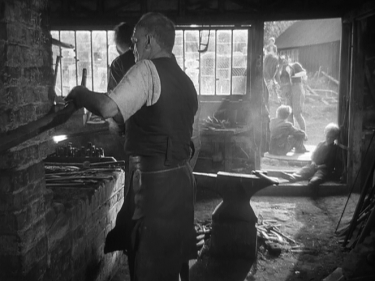
There is no doubt that World War II constituted a radical “earthquake” that shook the very foundations upon which moral and cultural values had historically been based. Yet, the ending of the film offers a hopeful vision, one which not only stresses the continuity between Chaucer’s pilgrims from six hundred years before and the film’s war era pilgrims of the mid 1940s, but also pays homage to the power of the human need for love, for spirituality, for art and for a symbiotic relationship with nature. Viewed today, however, A Canterbury Tale poses a whole new set of troubling questions, not the least of which is whether the film is now most usefully read as a cautionary tale. Wars continue to rage and our ecological fragility is acute. Have we got another six hundred years to save the planet?


